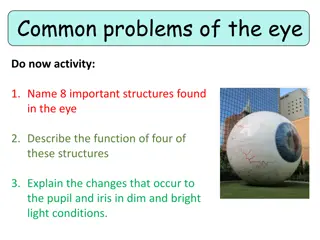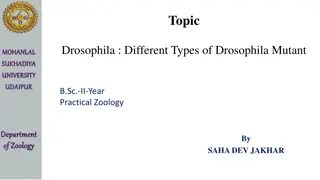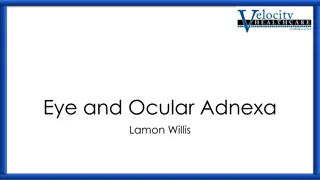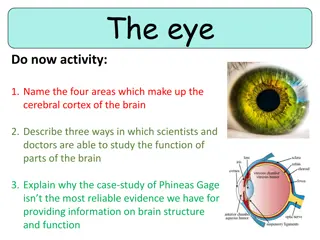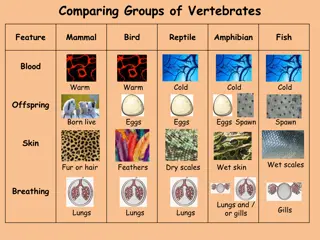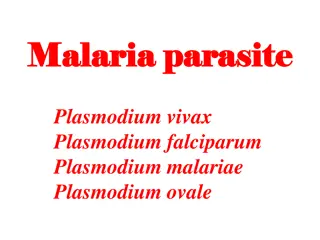Exploring the Intricacies of Vertebrate Eye Biology
Delve into the fascinating world of vertebrate eye biology with a focus on the retina, rods, cones, and the intricate mechanisms involved in light detection. Learn about photoreceptor cells, rhodopsin, photopsins, and the pathways that lead to nerve impulse generation in response to light stimuli.
Download Presentation

Please find below an Image/Link to download the presentation.
The content on the website is provided AS IS for your information and personal use only. It may not be sold, licensed, or shared on other websites without obtaining consent from the author. Download presentation by click this link. If you encounter any issues during the download, it is possible that the publisher has removed the file from their server.
E N D
Presentation Transcript
The Vertebrate Eye Unit 1 Cells and Proteins Advanced Higher Biology Miss Aitken
The Vertebrate Eye In the eye of all vertebrates, there is a structure called the retina The retina contains two types of photoreceptor cells Photoreceptor cells are cells that detect and respond to light The two types are called Rods and Cones.
The Vertebrate Eye Rods function in dim light but don t allow for colour perception Cones function only in bright light and are responsible for colour vision
Detecting Light In eyes, a light sensitive molecule called retinal captures light energy. Retinal comes from Vitamin A carrots!! Retinal is a prosthetic group to a polypeptide called opsin = rhodopsin The rhodopsin complex is embedded in the cell membrane inside photoreceptor cells. Rods contain rhodopsin to detect low light levels Cones contain photopsins to detect colours
Rhodopsins (in Rod Cells) and Photopsins (in Cone Cells) There is a pathway to stimulate both of these molecules.
Rod Cells, Rhodopsin and the Nerve Impulse In darkness: Rhodopsin inactive Rod cell produces molecules called cyclic GMP (cGMP) cGMP binds to ligand-gated Sodium (Na+) channels, keeping channels open so sodium ion flow across the membrane Membrane depolarised No nerve impulse generated
Rod Cells, Rhodopsin and the Nerve Impulse In light: Retinal absorbs light, causing a conformational change, making rhodopsin active (photoexcited rhodopsin) Change in the rhodopsin activates hundreds of molecules of a G protein called transducin This activates hundreds of molecules of an enzyme called phosphodiesterase. Phosphodiesterase causes breakdown of cGMP, causing Sodium channels to close, stopping Sodium ions moving in. A sufficient build up of sodium ions causes hyperpolarisation Generation of a nerve impulse
Rod Cells, Rhodopsin and the Nerve Impulse When light hits the rod cell, a protein cascade occurs: Rhodopsin -> Transducin -> Phosphodiesterase -> Channels This method has a high degree of amplification, meaning a single photon results in a large effect. This means rods are extremely sensitive, even in low light levels.
Essay Question Describe the role of photoreceptors (rods and cones) in triggering a nervous impulse in animal eyes (8)
Rhodopsin is the light sensitive molecule/protein in rod cells (1) Rhodopsin is retinal combined with opsin (1) Cone cells are sensitive to specific/different wavelengths/colours (1) In cone cells, different forms of opsin combine with retinal (1) Very high degree of amplification in rod cells (1) ...which means rod cells are sensitive in low light intensities/situations (1) One photon can stimulate rhodopsin (1) A cascade of proteins amplifies the signal (1) Hundreds of G protein molecules are activated (1) Activates hundreds of enzyme molecules (1) Enzymes generate a product (1) Sufficient product made leads to a nerve impulse (1)
Cones Less sensitive than rods Less photoreceptor cells Instead of rhodopsin, they have photopsins Photopsins are made by combining different forms of retinal with opsin Three types red, green and blue All photopsins have different sensitivities to different wavelengths of light







